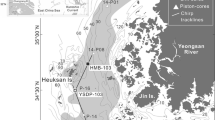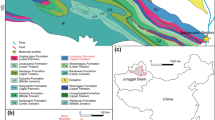Abstract
A distinction between the classic Bouma turbidite and a hyperpycnite is needed because hyperpycnal flows provide a direct link between the terrestrial source and the depositional sink. These deposits are a potential record of river floods and hence contain tectonic and climatic information. Unlike the sandy turbidite or hyperpycnite, the muddy counterpart is generally poorly documented. Based on detailed sedimentological analysis of a deltaic mudstone unit within the Cretaceous Hwangsan Tuff, SW Korea, this paper addresses the characteristics and depositional processes of the lacustrine muddy turbidite or hyperpycnite. The Hwangsan Tuff is composed of reworked volcaniclastics up to 300 m thick, deposited in a lake margin, on a delta front to the basin plain. The thin-bedded mudstones constitute a diverse type of turbidites. Most mudstone beds generally show normal grading and are wavy in form, but internally demonstrate the existence of a depositional break such as an erosional surface and the repetition of rippled units. Thin-bedded mudstone with a pronounced normal grading is interpreted to have been deposited by small, dilute turbidity currents. However, a composite bed of lower massive siltstone overlain by a structureless claystone suggests deposition from slow-moving, high-density flows with high clay content. The hyperpycnal flow deposits in muds are characterized by a thickness change in the horizontal laminae, internal erosion scour, and the recurrence of rippled units, all of which are features indicating deposition from flow fluctuations in long-lived hyperpycnal flows. Abundant plant debris and a lack of bioturbation also support this hypothesis. The hyperpycnal flows form the mouth bars to delta front bodies of the lake margin.
Similar content being viewed by others
References
Arnott, R.W. and Hand, B.M., 1989, Bedforms, primary structures and grain fabric in the presence of suspended sediment rain. Journal of Sedimentary Petrology, 59, 1062–1069.
Ashley, G.M., Shaw, J., and Smith, N.D., 1985, Glacial Sedimentary Environments. SEPM Short Course Note No. 16, 246 p.
Baas, J.H. and Best, J.L., 2008, The dynamics of turbulent, transitional and laminar clay-laden flow over a fixed current ripple. Sedimentology, 55, 635–666.
Baas, J.H., Best, J.L., and Peakall, J., 2011, Depositional process, bedform development and hybrid bed formation in rapidly decelerated cohesive (mud-sand) sediment flows. Sedimentology, 58, 1953–1987.
Baas, J.H., Best, J.L., Peakall, J., and Wang, M., 2009, A phase diagram for turbulent, transitional, and laminar clay suspension flows. Journal of Sedimentary Research, 79, 162–183.
Best, J.L. and Bridge, J., 1992, The morphology and dynamics of low amplitude bedwaves upon upper stage plane beds and the preservation of planar laminae. Sedimentology, 39, 737–752.
Best, J.L., Kostaschuk, R.A., Peakall, J., Villard, P.L., and Franklin, M., 2005, Whole flow field dynamics and velocity pulsing within natural sediment-laden underflows. Geology, 33, 765–768.
Bhattacharya, J.P. and MacEachern, J.A., 2009, Hyperpycnal rivers and prodeltaic shelves in the Cretaceous Seaway of North America. Journal of Sedimentary Research, 79, 184–209.
Bouma, A.H., 1962, Sedimentology of some flysch deposits. Elsevier, Amsterdam, 168 p.
Bourget, J., Zaragosi, S., Mulder, T., Schneider, J.-L., Garlan, T., Van Toer, A., Mas, V., and Ellouz-Zimmermann, N., 2010, Hyperpycnal-fed turbidite lobe architecture and recent sedimentary processes: a case study from the Al Batha turbidite system, Oman margin. Sedimentary Geology, 229, 144–159.
Bridge, J. and Best, J., 1997, Preservation of planar laminae due to migration of low-relief bed waves over aggrading upper-stage plane beds: comparison of experimental data with theory. Sedimentology, 44, 253–262.
Buatois, L.A. and Mangano, M.G., 1994, Lithofacies and depositional processes from a Carboniferous lake, Sierra de Narvaez, northwest Argentina. Sedimentary Geology, 93, 25–49.
Buatois, L.A. and Mangano, M.G., 1995, Sedimentary dynamics and evolutionary history of a Late Carboniferous Gondwanic lake in north-western Argentina. Sedimentology, 42, 415–436.
Calvo, J.P., Rodriguez-Pascua, M., Martin-Velazquez, S., Jimenez, S., and de Vicente, G., 1998, Microdeformation of lacustrine laminite sequences from Late Miocene formations of SE Spain: an interpretation of loop bedding. Sedimentology, 45, 279–292.
Chang, T.S., 1998, Facies analysis of fine-grained volcaniclastic lacustrine turbidite on the northern coast of Jindo and adjacent Area. M.Sc. thesis, Chonnam National University, Gwangju, 115 p.
Cheel, R.J., 1990, Horizontal lamination and the sequence of bed phases and stratification under upper-flow-regime conditions. Sedimentology, 37, 517–529.
Chun, S.S. and Chough, S.K., 1995, The Cretaceous Uhangri Formation, SW Korea: lacustrine margin facies. Sedimentology, 42, 293–322.
Chun, S.S., 1990, Sedimentary processes, depositional environments and tectonic settings of the Cretaceous Uhangri Formation, southwest Korea. Ph. D. dissertation, Seoul National University, Seoul, 328 p.
Dasgupta, P., 2003, Sediment gravity flow—the conceptual problems. Earth-Science Reviews, 62, 265–281.
Hesse, R. and Chough, S.K., 1980, The northwest Atlantic mid-ocean channel of the Labrador Sea: II. Deposition of parallel laminated levee-muds from the viscous sublayer of low density turbidity currents. Sedimentology, 27, 697–711.
Higgs, R., 1991, The Bude Formation (lower Westphalian), SW England: siliciclastic shelf sedimentation in a large equatorial lake. Sedimentology, 38, 445–469.
Jones, M.E. and Preston, R.M.F., 1987, Deformation of sediments and sedimentary rocks. Geological Society, Special Publication, 29, 350 p.
Kim, S.B., Chough, S.K., and Chun, S.S., 2003, Tectonic controls on spatio-temporal development of depositional systems and generation of fining-upward basin fills in a strike-slip setting: Kyokpori Formation (Cretaceous), south-west Korea. Sedimentology, 50, 639–665.
Kneller, B., 1995, Beyond the turbidite paradigm: physical models for deposition of turbidites and their implications for reservoir prediction. In: Hartley, A.J. and Prosser, D.J. (eds.), Characterization of Deep Marine Clastic Systems. Geological Society, Special Publication, 94, 31–49.
Kneller, B.C. and Buckee, C., 2000, The structure and fluid mechanics of turbidity currents: a review of some recent studies and their geological implications. Sedimentology, 47,supplement 1, 62–94.
Koh, S.M. and Chang, H.W., 1996, Geological interpretation on the Cretaceous strata in the Haenam area, Chollanamdo, Korea. Journal of the Korean Society of Economic and Environmental Geology, 29, 381–393.
Lamb, M.P. and Mohrig, D., 2009, Do hyperpycnal-flow deposits record river-flood dynamics? Geology, 37, 1067–1070.
Lamb, M.P., McElroy, B., Kopriva, B., Shaw, J., and Mohrig, D., 2010, Linking river-flood dynamics to hyperpycnal-plume deposits: experiments, theory, and geological implications. GSA Bulletin, 122, 1389–1400.
Lamb, M.P., Myrow, P.M., Lukens, C., Houck, K., and Strauss, J., 2008, Deposits from wave-influenced turbidity currents: Pennsylvanian Minturn Formation, Colorado, U.S.A. Journal of Sedimentary Research, 78, 480–498.
Lowe, D.R., 1982, Sediment gravity flows. II. Depositional models with special reference to the deposits of high-density turbidity currents. Journal of Sedimentary Petrology, 52, 279–297.
Lowe, D.R., 1988, Suspended-load fallout rate as an independent variable in the analysis of current structures. Sedimentology, 35, 765–776.
Luthi, S., 1980, Some new aspects of two-dimensional turbidity current. Sedimentology, 28, 97–105.
Mantz, P.A., 1978, Bedforms produced by fine, cohesionless, granular and flakey sediments under subcritical water flows. Sedimentology, 25, 83–103.
Miall, A.D., 1977, A review of the braided-river depositional environment. Earth-Science Reviews, 13, 1–62.
Mulder, T. and Alexander, J., 2001, The physical character of subaqueous sedimentary density flows and their deposits. Sedimentology, 48, 269–299.
Mulder, T., Migeon, S., Savoye, B., and Faugeres, J.-C., 2001b, Inversely graded turbidite sequences in the deep Mediterranean: a record of deposits from flood-generated turbidity currents? Geo-Marine Letters, 21, 86–93.
Mulder, T., Migeon, S., Savoye, B., and Jouanneau, J.-M., 2001a, Twentieth century floods recorded in the deep Mediterranean sediments. Geology, 29, 1011–1014.
Mulder, T., Syvitski, J.P.M., Migeon, S., Faugeres, J.-C., and Savoye, B., 2003, Marine hyperpycnal flows: initiation, behavior and related deposits. A review. Marine and Petroleum Geology, 20, 861–882.
Myrow, P.M., Lukens, C., Lamb, M.P., Houck, K., and Strauss, J., 2008, Dynamics of a transgressive prodeltaic system: implications for geography and climate within a Pennsylvanian intracratonic basin, Colorado, U.S.A. Journal of Sedimentary Research, 78, 512–528.
Nakajima, T., 2006, Hyperpycnites deposited 700 km away from river mouths in the Central Japan Sea. Journal of Sedimentary Research, 76, 60–73.
Nemec, W. and Steel, R.J., 1984, Alluvial and coastal conglomerates: their significant features and some comments on gravelly massflow deposits. In: Koster, E.H. and Steel, R.J. (eds.), Sedimentology of Gravels and Conglomerates. Canadian Society of Petroleum Geologists Memoirs, 10, 1–31.
Nemec, W., 1995, The dynamics of deltaic suspension plumes. In: Oti, M.N. and Postma, G. (eds.), Geology of Deltas. A.A. Balkema, Rotterdam, p. 31–93.
Olariu, C., Steel, R.J., and Petter, A.L., 2010, Delta-front hyperpycnal bed geometry and implications for reservoir modeling: Cretaceous Panther Tongue delta, Book Cliffs, Utah. AAPG Bulletin, 94, 819–845.
Paola, C., Wiele, S.M., and Reinhart, M.A., 1989, Upper-regime parallel lamination as the result of turbulent sediment transport and low-amplitude bed forms. Sedimentology, 36, 47–59.
Petter, A.L. and Steel, R.J., 2006, Hyperpycnal flow variability and slope organization on an Eocene shelf margin, Central Basin, Spitsbergen. AAPG Bulletin, 90, 1451–1472.
Pickering, K.T., Stow, D.A.V., Watson, M.P., and Hiscott, R.N., 1986, Deep-water facies, processes and models: a review and classification scheme for modern and ancient sediments. Earth-Science Reviews, 23, 75–174.
Pickering, K.T., 1979, Possible retrogressive flow slide deposits from Kongsfjord Formation: a Precambrian submarine fan, Finmark, N. Norway. Sedimentology, 26, 295–306.
Piper, D.J.W., 1978, Turbidite muds and silts on deep sea fans and abyssal plains. In: Stanley, D.J. and Kelling, G. (eds.), Sedimentation in Submarine Canyons, Fans, and Trenches. Dowden, Hutchinson and Ross, Stroudsburg, PA, p. 163–176.
Piper, D.J.W., Cochonat, P., and Morrison, M.L., 1999, The sequence of events around the epicentre of the 1929 Grand Banks earthquake: initiation of debris flows and turbidity current inferred from sidescan sonar. Sedimentology, 46, 79–97.
Postma, G., 2001, Physical climate signatures in shallow- and deepwater deltas. Global and Planetary Change, 28, 93–106.
Postma, G., Nemec, W., and Kleinspehn, K.L., 1988, Large floating clasts in turbidites: a mechanism for their emplacement. Sedimentary Geology, 58, 47–61.
Shultz, A.W., 1984, Subaqueous debris flow deposition in the Upper Paleozoic Culter Formation, western Colorado. Journal of Sedimentary Petrology, 54, 759–772.
Slatt, R.M. and Zavala, C., 2011, Sediment transfer from shelf to deep water—revisiting the delivery system. AAPG Studies in Geology, 61, 214 p.
Sohn, Y.K., 1997, On traction-carpet sedimentation. Journal of Sedimentary Research, 67, 502–509.
Son, J.D., Yoo, H.S., Kim, H.Y., Ko, M.Y., Cho, D.H., Koo, J.H., and Kim, S.G., 1980, Geology, geochemical and geophysical exploration for the Cretaceous strata containing oily shale in Haenam and Mogpo area. Bulletin of the Korea Institute of Geosciences and Mineral Research, 21, 51 p. (in Korean).
Soyinka, O.A. and Slatt, R.M., 2008, Identification and micro-stratigraphy of hyperpycnites and turbidites in Cretaceous Lewis Shale, Wyoming. Sedimentology, 55, 1117–1133.
Stow, D.A.V. and Bowen, A.J., 1980, A physical model for the transport and sorting of fine-grained sediment by turbidity currents. Sedimentology, 27, 31–46.
Stow, D.A.V. and Piper, D.J.W., 1984, Deep-water fine-grained sediments: Facies models. In: Stow, D.A.V. and Piper, D.J.W. (eds.), Fine-grained Sediments: Deep-water Processes and Facies. Geological Society, Special Publication, 15, 611–646.
Sturm, M. and Matter, A., 1978, Turbidites and varves in Lake Brienz, Switzerland: deposition of clastic detritus by density currents. In: Matter, A. and Tucker, M.E. (eds.), Modern and Ancient Lake Sediments. International Association of Sedimentologists. Special Publication, 2, 147–168.
Surlyk, F., 1984, Fan-delta to submarine fan conglomerates of the Volgian-Valanginian Wollaston Forland Group, East Greenland. In: Koster, E.H. and Steel, R.J. (eds.), Sedimentology of Gravels and Conglomerates. Canadian Society of Petroleum Geologists Memoirs, 10, 359–382.
Van Loon, A.J., Brodzikowski, K., and Zielinski, T., 1995, Shockinduced resuspension deposits from a Pleistocene proglacial lake (Kleszczow Graben, central Poland). Journal of Sedimentary Research, A65, 417–422.
Zavala, C., Arcuri, M., and Blanco Valiente, L., 2012, The importance of plant remains as diagnostic criteria for the recognition of ancient hyperpycnites. Revue de Paleobiologie, 31, 457–469.
Zavala, C., Arcuri, M., Di Meglio, M., Gamero Diaz, H., and Contreras, C., 2011, A genetic facies tract for the analysis of sustained hyperpycnal flow deposits. In: Slatt, R.M. and Zavala, C. (eds.), Sediment Transfer from Shelf to Deep Water-Revisiting the Delivery System. AAPG Studies in Geology, 61, p. 31–51.
Zavala, C., Ponce, J.J., Arcuri, M., Drittanti, D., Freije, H., and Asensio, M., 2006, Ancient lacustrine hyperpycnites: a depositional model from a case study in the Rayoso Formation (Cretaceous) of West-Central Argentina. Journal of Sedimentary Research, 76, 41–59.
Author information
Authors and Affiliations
Corresponding author
Rights and permissions
About this article
Cite this article
Chang, T.S., Chun, S.S. Micro-characteristics of sustained, fine-grained lacustrine turbidites in the Cretaceous Hwangsan Tuff, SW Korea. Geosci J 16, 409–420 (2012). https://doi.org/10.1007/s12303-012-0042-3
Received:
Accepted:
Published:
Issue Date:
DOI: https://doi.org/10.1007/s12303-012-0042-3




